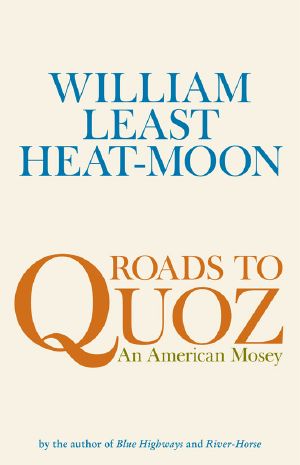Roads to Quoz · an American Mosey

- Authors
- Heat-Moon, William Least
- Publisher
- Little, Brown
- Tags
- non-fiction , philosophy , travel , trv025000
- ISBN
- 9780316040181
- Date
- 2008-10-29T00:00:00+00:00
- Size
- 1.80 MB
- Lang
- en
About a quarter century ago, a previously unknown writer named William Least Heat-Moon wrote a book called Blue Highways. Acclaimed as a classic, it was a travel book like no other. Quirky, discursive, endlessly curious, Heat-Moon had embarked on an American journey off the beaten path. Sticking to the small places via the small roads--those colored blue on maps--he uncovered a nation deep in character, story, and charm. Now, for the first time since Blue Highways, Heat-Moon is back on the backroads. ROADS TO QUOZ is his lyrical, funny, and touching account of a series of American journeys into small-town America.
From Publishers WeeklyStarred Review. It was almost a decade ago that Least Heat-Moon (Blue Highways) followed the trail of Lewis and Clark in River Horse; in the first section of his latest peripatetic writings, he and his wife, Q, trace the lesser-known Dunbar-Hunter Expedition of 1804 through the southern half of the Louisiana Purchase, searching out the head of the Ouachita River in Arkansas. Least Heat-Moon's fans will find this territory, and that covered in the five other journeys to places a goodly portion of the American populace would call 'nowhere,' instantly familiar, as he and various companions take digressive paths from one small opolis (where anything metro was clearly missing) to the next in search of quoz (an 18th-century word meaning anything out of the ordinary). Among his many adventures, Least Heat-Moon rides a bicycle along an abandoned railroad track, discovers a road to nowherebuilt by a Florida county so local drug smugglers would have a landing strip, and comes up with what he believes is the real story behind the murder of his great-grandfather. Or maybe the highlights of these journeys are the people he meets along the way and their stories, like the man who tried to fund a school for disadvantaged children by providing lonely widows with special massages, or the artist who's turned his cabin into a walk-in kaleidoscope. Either way, few readers will be able to resist tagging along. (Oct. 29) Copyright © Reed Business Information, a division of Reed Elsevier Inc. All rights reserved.
From BooklistStarred Review Heat-Moon’s love for back roads, buried history, mesmerizing stories, and colorful language launched a life of inquisitive travels and meticulous writing. In his fifth book, this attentive listener and observer and sly wit in the mode of Twain reports on his quest for quoz, that is, “anything strange, incongruous, or peculiar.” Accompanied by his smart, funny lawyer-historian wife, Q, Heat-Moon follows the 1804 trail of William Dunbar and George Hunter on the “forgotten” Jeffersonian mission along the Ouachita River through Arkansas and Louisiana. Amidst hilarious commentary on road food and uncharismatic small towns, Heat-Moon continues on to Florida, Maine, New Mexico, Missouri, Montana, Oklahoma, and Texas, writing vividly and insightfully about diverse and quirky places. But it is the people he meets, or resurrects, that give this spellbinding and immensely satisfying book its soul. From freethinker William Grayson, shot down on the street in Joplin, Missouri, in 1901 (Heat-Moon finally solves the case) to artist Indigo Rocket, a “wizard of quoz”; Jean Ingold, whose “carbon footprint was that of a cat”; conservator James Canary, guardian of Kerouac’s On the Road scroll; Glenn Gore, who is dedicated to photographing “every mile” of the Ouachita; and Frank Xavier Brusca, who is doing the same for U.S. Highway 40. Natural, national, and personal history converge in this resplendent “mosey,” an inspiriting antidote to hurry and a profound tribute to this good land and its people. --Donna Seaman